Nokia Lumia 900 Review - Windows Phone with LTE
by Brian Klug on April 3, 2012 9:00 PM ESTIt goes without saying that for Nokia, the Lumia 900 launch is quite possibly one of the most important launches, ever. The Lumia 900 marks Nokia’s first serious foray back into the competitive American market, and with it the first high-end fruit to come out of its new strategic partnership with Microsoft. Just how well the Lumia 900 does in the USA will be a reflection on both Nokia’s industrial design, and Microsoft’s still somewhat fledgling Windows Phone 7 smartphone platform.
First a bit of recapitulation - the Lumia 900 is not the Finnish handset maker’s first smartphone for the USA, that illustrious title belongs to the Lumia 710 on T-Mobile which we reviewed a while ago. Nor is the Lumia 900 Nokia’s first Windows Phone device, as that title belongs to the Lumia 800. Following the naming scheme, it’s easy to see where the Lumia 900 is positioned relative to the 800, 710, and upcoming 610, namely at the very top of Nokia’s new Lumia Windows Phone product line. This is Nokia’s AAA smartphone aimed straight at the jugular of both the best Android smartphones and the iPhone 4S.
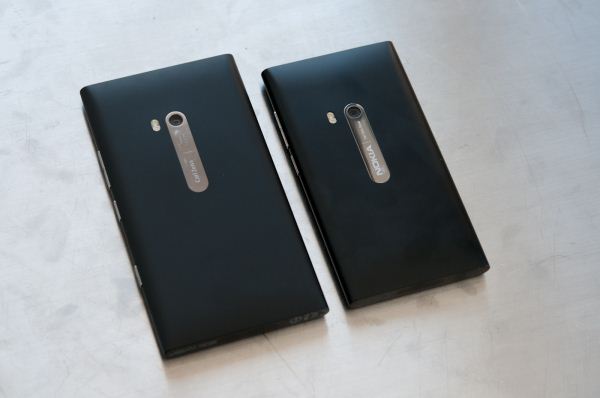
Nokia Lumia 900 (left), Nokia N9 (right)
It’s always easiest to start one of these reviews out simply by talking about the superficial physical aspects of the phone. In this case, the Lumia 900 design is an obvious descendant of the Nokia N9 and Lumia 800, keeping the same semi-cylindrical shape shape but increasing the display size from 3.7“ to a much more US-friendly 4.3”. In the process, the Lumia 900 does lose the Lumia 800/Nokia N9’s curved glass front face. Instead, the 900’s front visage is one planar piece of glass.
Just above the Nokia logo on the front is the 900’s 720p front facing camera, and unlike the 800 the primary earpiece is placed right where the front glass meets the body. There’s a small raised lip around the front glass which ostensibly holds the display in place (and glass under compression) which also guarantees you can lay the phone flat on its face on a flat surface and not put sleeks (scratches) into the display.
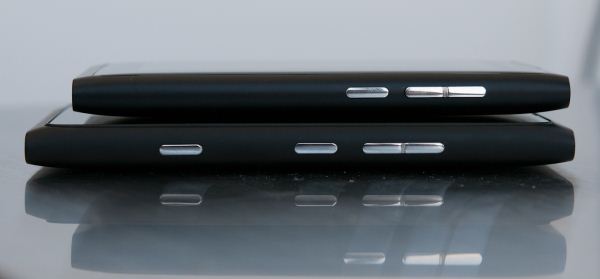
Nokia Lumia 900 (bottom), Nokia N9 (top)
That’s really the only major physical change however. Like the 800, the 900’s body is still unibody polycarbonate, with the same volume rocker, power/standby, and camera button (from top to bottom) arrangement on the right side. The texture of the 900’s case somehow feels different and slightly rougher than the 800, which is something of an improvement - the result is a device which feels even less slick with greasy or sweaty palms. Side by side with an N9, you can tell the plastic surface is textured differently under the right lighting, but it isn't an immediately obvious thing. It’s still amazing how Nokia is able to craft a device entirely out of plastic, and yet avoid the same pitfalls that continue to make Samsung devices feel, well, plasticky. Clearly not all polymer is the same here.
The rest of the exterior is again very much a throwback to the 800, with some welcome changes. At the bottom, dead center is the speakerphone grille and primary microphone. The regulatory markings, model, and FCC ID are printed here instead of in the microSIM tray.
On the back, the 900 goes with an offset flash position that resembles the N9. There’s also the same shiny chrome badge bearing Carl Zeiss branding and F/2.2, 28mm markings for the 8 MP camera module. Like the 800, this is perhaps the only design aspect of the 900 I find puzzling, since this chrome badge and camera region is coplanar with the surface the smartphone is set down on, and the result is that it instantly picks up scratches. You can even see them here in a gallery image, and I'm super paranoid about loaner devices - it's not like I have steel wool in my pocket either. Unlike the 800 there’s no cutout just above the flash for a noise canceling microphone, that’s moved up to the top of the 900.
At the top we see some of the other (possibly AT&T-influenced?) changes to the 800 design. Gone is the magnetic swing-open door for microUSB, instead the port is simply dead center. At far left is the standard headphone jack, followed by the noise cancelation secondary microphone, microUSB, and the microSIM tray’s eject hole. Nokia accommodates this microSIM tray with a bundled SIM ejector tool in the box. It’s interesting how so many designs are now going this route, admittedly I doubt most US customers do much SIM swapping outside their carrier store.
The Lumia 900 feels like a larger (in x and y), thinner Lumia 800. It literally ends up being exactly like what you’d expect if you were to take an 800 and pull at the top and bottom, increasing the areal size of the device and making it thinner at the same time. I realize that doesn’t help prospective buyers in the US who have never seen a Lumia 800 (or an N9) but for Europeans who have been holding out for Nokia’s high-end flagship, know that it’s like an even better 800 on the outside.
The same design caveats also apply here - specifically, there’s no removable battery (it’s sealed inside) and no external storage in the form of a microSD card slot. The former is a design tradeoff which lets Nokia craft hardware that’s thin, solid, and attractive, the latter is more of a Windows Phone 7 software architecture thing. At this point high-end devices shipping with sealed internal batteries seems to be the norm, and the mitigation is to ship an external battery which charges the device over microUSB.
Smartphones, like cars, also seem to be getting bigger, and the Lumia 900 is no exception. I think it’s an interesting thing to note that the AAA smartphone Nokia has targeted for launch in the US has a 4.3“ display (which I guess is almost small by today’s standards). Obviously there’s a certain level of specsmanship which OEMs have to contend with, and somewhere between 4.3” and 4.65" is starting to emerge as a practical upper bound for display size.
At the bottom of the display are the three Windows Phone buttons, which are capacitive and backlit. I find the backlighting to be a bit on the weaker side, and unfortunately at some brightness levels you can see a bit of light leakage from them into the display - it isn’t a lot however. The positioning near the bottom lip of the display isn’t too close to be a problem though, and the buttons are responsive.
The Lumia 900 we’re reviewing today is the AT&T LTE bound model 900.1, and thus came in the standard AT&T themed packaging I’m used to seeing. Inside is the device itself, a SIM ejector tool, microUSB cable, and a 5V 1A USB charger. What’s absent is a rubberized case tailored to the 900’s shape like what we saw with the 800, but that’s a comparatively small thing to gripe about
Next up is our comparison table, and the real difference here ends up being SoC. What’s unique about the Lumia 900 is inclusion of a 1.4 GHz Qualcomm APQ8055 instead of MSM8255. Both are 45nm, single core Qualcomm snapdragon with Adreno 205 graphics. If you’ve been following our SoC coverage, you probably already know the difference between these two parts is all cellular - APQ connotes a part with no cellular baseband, MSM (mobile station modem) means the part does have a cellular baseband enabled, 2 for 3GPP, 6 for 3GPP and 3GPP2 compliance.
| Physical Comparison | ||||||
| Samsung Focus S | Nokia Lumia 800 | Nokia Lumia 710 | Nokia Lumia 900 | |||
| Height | 126.1 mm (4.96") | 116.5 mm (4.59") | 119.0 mm (4.69") | 127.8 mm (5.03") | ||
| Width | 66.8 mm (2.63") | 61.2 mm (2.41") | 62.4 mm (2.46") | 68.5 mm (2.7") | ||
| Depth | 8.5 mm (0.33") | 12.1 mm (0.48") | 12.5 mm (0.49") | 11.5 mm (0.45") | ||
| Weight | 111 g (3.9 oz) | 142 g (5.0 oz) | 125.5 g (4.4 oz) | 160 g (5.6 oz) | ||
| CPU | 1.4 GHz Single Core Snapdragon MSM8255 | 1.4 GHz Single Core Snapdragon MSM8255 | 1.4 GHz Single Core Snapdragon MSM8255 | 1.4 GHz Single Core Snapdragon APQ8055 | ||
| GPU | Adreno 205 | Adreno 205 | Adreno 205 | Adreno 205 | ||
| RAM | 512 MB LPDDR2 | 512 MB LPDDR2 | 512 MB LPDDR2 | 512 MB LPDDR2 | ||
| NAND | 16 GB NAND (no external microSD) | 16 GB NAND (no external microSD) | 8 GB NAND (no external microSD) | 16 GB NAND (no external microSD) | ||
| Camera | 8 MP AF/LED, 1.3 MP front facing | 8 MP AF/Dual LED Flash, 720p Video Rec. | 5 MP AF/LED Flash, 720p Video Rec. | 8 MP AF/LED Flash, 720p Video Rec., 1.0 MP front facing | ||
| Screen | 4.3" 800 x 480 SAMOLED+ | 3.7" 800 x 480 SAMOLED w/ClearBlack | 3.7" 800 x4 80 TFT LCD w/ClearBlack | 4.3" 800 x 480 SAMOLED+ w/ClearBlack | ||
| Battery | Removable 6.1 Whr | Internal 5.37 Whr | Removable 4.81 Whr | Internal 6.77 Whr | ||
Windows Phone continues to be a Qualcomm-only platform, and we’ve talked before about how shipping a voice-enabled LTE phone at this point with Qualcomm requires a voice-enabled through SoC fusion platform. In this case, the platform is this combination of baseband-less APQ8055 and Qualcomm’s MDM9200 baseband for all cellular WCDMA and LTE. The rest of the specs are what you’d expect given the Windows Phone 7 chassis specification - 512 MB of LPDDR2, 16 GB of NAND (of which 13.61 GiB are available to the user), 8 MP rear camera and 1 MP front facing camera.
The context for the US AT&T Lumia 900 launch really is a story of both positioning, and price point - at $99 on two year contract with AT&T the Lumia 900 has been made impossible to ignore. Competition is good, and clearly some of AT&T’s self-positioning as the “premiere” Windows Phone 7 carrier platform is finally coming to the surface now with pricing that undercuts other AT&T herophones. Initial launch price aside, the Lumia 900 definitely does not make sacrifices to industrial design or build quality in any way, this is exactly what people were alluding to when they talked about Nokia building a Windows Phone. Winning at the high end is something that Windows Phone has arguably yet to do, and the Lumia 900 finally is a device that’s positioned the same way as some of the latest and greatest Android devices as well.


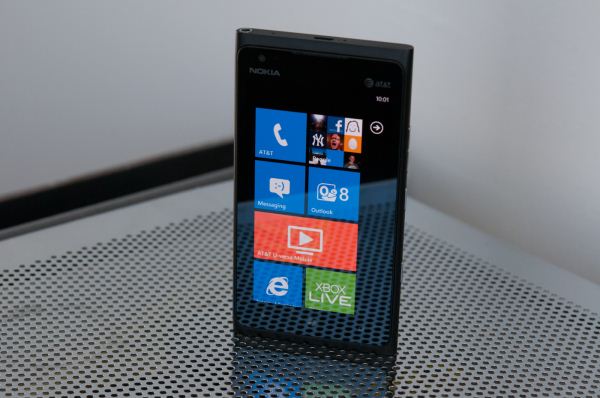
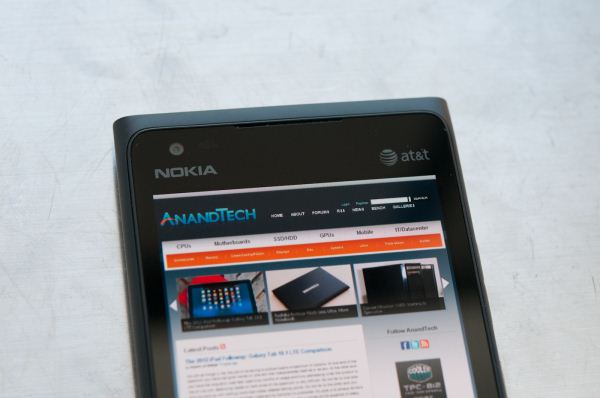


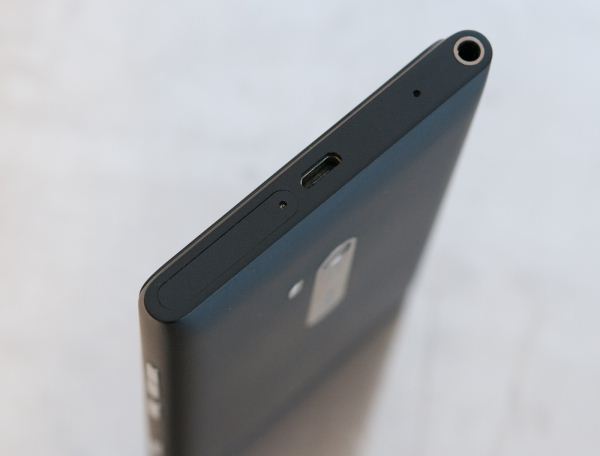
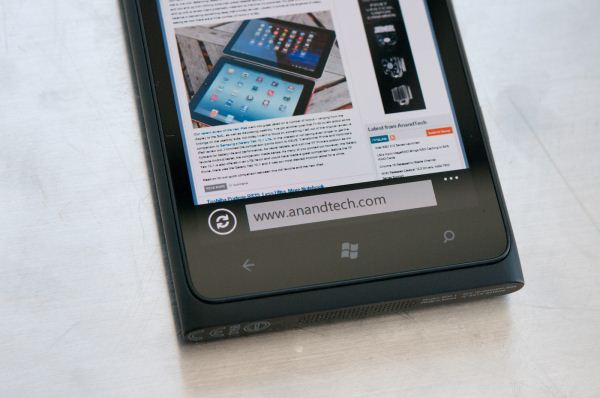
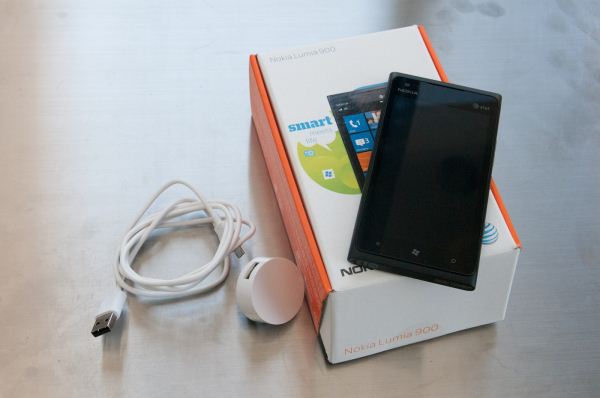














128 Comments
View All Comments
UltraTech79 - Saturday, April 7, 2012 - link
Also, no most people do NOT like the design, else they would be buying these and not Droids/iPhones by the truckload.jmcb - Tuesday, April 10, 2012 - link
To me battery life on WP7 has never been as great as many claim since WP7 launched. I usually reference this site for results, debates.Battery life is part of my deal breakers for any phone.
gamoniac - Tuesday, April 3, 2012 - link
[quoteThe article: ]...the only major gripes I have with Nokia Drive are that the application arguably should change between night and daytime map colors automatically...[/quote]I checked out this feature at the store, I think WP7 should let you decide whether to let the map color or to set it to manual mode. Some people might find the daylight map easier to read during the night.
vision33r - Tuesday, April 3, 2012 - link
Well, in general if Android doesn't suck so much none of us really need a quad-core phone. Clearly WP is much more efficient platform than Android today so a single-core phone can be this solid and for most people this translates to feeling faster than most Android phones that lags when apps are running and sans performance.Nearly every Android device I've used today needs manual management in order to run smoothly. Letting a single widget or app sitting background too long, battery life and performance suffers. Android's entire ecosystem is to blame for faulty app coding to OS builds rigged with bloatware.
This is a refreshing device, hopefully people will not care about the specs and embrace efficiency and good hardware and software designs.
gamoniac - Tuesday, April 3, 2012 - link
I totally agree. I am held back from jumping on a WP7 for two reasons: WP8 is coming and a dual-core WP would be great.I respect AnandTech's spirit of journalism that makes it stand out among review sites. At the same time, I wonder if there is a fair way to rate the phone based on total user experience, in a somewhat quantifiable way, as opposed to core count or a simple opinion. Perhaps a weighted score of each of the categories, although that could still be subjective. Perhaps a short video review? Maybe some AT readers have some brilliant ideas to share.
davepermen - Wednesday, April 4, 2012 - link
a total user experience rating?here it is:
always smooth, always instant, never stuttering.
why should I care about "faster hardware" if the phone is already perfoming at it's best possible speed?
this rating is based on the lumia 800 i own.
i've yet to find an android phone as smooth and fast as the lumia 800.
i can't wait for apollo, out of the curiosity of what's all in there, and all those tiny features that a win8 kernel brings (WPS for Wifi connection, for example, proper windows updates, etc).
but at no point i wait for apollo to "get a fast phone". because i already have that.
french toast - Wednesday, April 4, 2012 - link
Yes good point..its efficient and fast..but too be honst Meego and even Symbian is even faster still..running on even worse hardware than this....The point is smoothness and efficiency is great...brilliant, but what about things like batterylife? HD displays? powerfull apps and GAMES?? 1080p video recording and editing?? True multitasking?? its not all just about sending a few emails, checking facebook, and floating around in the opererating system...on android and ios you can do soo much more than that...the apps are much better..and the games are just not possible at smooth frame rates on that crappy Snapdragon.
About the efficiency...you realise that now ICSv 4 has been released and Tegra 3/Snapdragon S4 have been loaded...that lag is a non issue anymore??
Even with giant HD display...and the resource hungry Sense overlay..a mobile phone has NEVER looked so good and been so slick..WHILST DOING COMPLICATED THINGS (thats the kicker that seperates a SMARTPHONE from FEATURE PHONE)
For the record im not anti Nokia or anti microsoft..im a fan of both..and will be buying WP8...this is actually the first WP7 device that i would own...as Anand says, considering the 1 year to get this from design to market..and considering the crap components Nokia has to work with..this Nokia 900 is a revelation..Can't wait till Q4 ;)
For a comparison..this is what a modern Android SMARTPHONE is comapred to the best WP7 has to offer;
HTC ONE X REVIEW PT1;
http://www.youtube.com/watch?v=gotEbvgu9ms
PT2
http://www.youtube.com/watch?v=p4LQXtV5z0Q&fea...
Note, that despite hulking around a massive 4.7 HD screen, a quad core tEGRA 3 processor 1gb ram..and the same size battery..the ONE X likely gets much better batterylife than this Lumia 900...(after the OTA firmware update, early reviews had average battery because of this)
gamoniac - Wednesday, April 4, 2012 - link
Those are great review videos. Thanks for the links. HTC One X is quite an impressive piece of device, I must say. As an android user who is not so happy, I can see that ICS has improved quite a bit.leexgx - Friday, April 6, 2012 - link
still the hardware requirement to make it smooth is very bad for android, Tegra 3 + android = smooth , any thing els is hit or missevery thing on windows 7 phones are GPU driven so no lag due to that and the basic hardware is set quite high (but users thing its low not sure what Dual core win7phones will do), compared to android where any thing goes so you end up with lackluster phones when they should not be even when they are dual core or higher as most apps are not GPU driven they can stall and make the phone laggy (Slow NAND as well i see a lot on android as well)
when my phone contract runs out i most likely get an windows phone as i need the calendar cant use the one quickly on android (i have always used an windows Mobile device before, i broke the screen on my last one and ended up with an 8520 as an test then 9870 as i got used and liked it, but i do prefer windows phones)
sonicmerlin - Saturday, April 7, 2012 - link
HTC One X doesn't get better battery life. You missed the line where Brian states subjectively the battery life of the Lumia 900 is much better than the tests suggest.One of the aggravations of Android is that standby drains huge amounts of battery. Leaving radios on, having widgets running in the background, keeping data and background sync on, etc. drain your battery like a fiend even while your phone is on standby.
WP7 and iOS don't suffer from these issues (iOS fixed them in firmware 5.1, Nokia fixed them after 5 firmware updates to the Lumia 800), and over the course of a day will last you much, much longer than any Android phone.